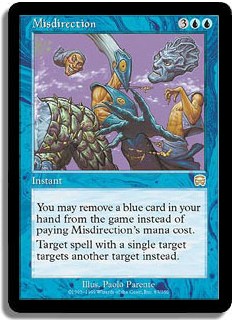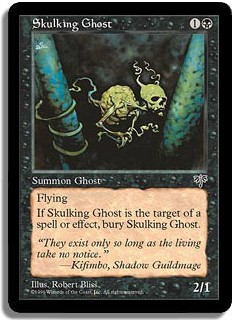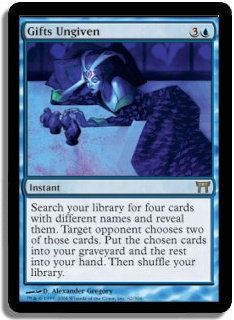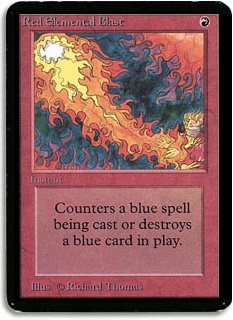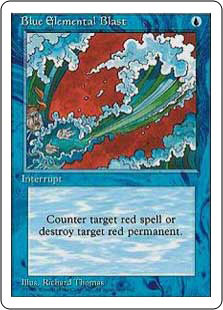There was a forum topic over on The Mana Drain recently where someone brought up a simple, but excellent question; which is better, Pyroblast or Red
Elemental Blast? Do you run one or the other, or some specific ratio of the two?
If you’re not familiar with the subtle difference, Red Elemental Blast can only be played targeting a red spell or permanent. Pyroblast can target
anything but only destroys it if it happens to be blue.
This is such a stunningly perfect example of what I talked about last week; I’m a little upset I
missed it then. I began to write a forum response, but it just got longer and longer until I realized the topic was worthy of an article unto itself.
The mechanical differences between these cards are extremely minor. If you’re going to run one of these cards, it’s because you want to stop blue cards
– and these both fill that role identically.
Redirection
If you use Pyroblast to destroy a blue permanent, and your opponent has Misdirection, Divert, Commandeer, or another “change target”
effect, they can switch the target to something else random, typically a land. Since the land is not blue, the Pyroblast will have no effect, which
basically just means they turned their Misdirection into a Force of Will.
On the other hand, if you had used a Red Elemental Blast, they would need a second blue permanent to redirect it to because a land (barring
Thoughtlace) isn’t a legal target, and they need to chose a legal target with their spell.
Red Elemental Blast wins that battle, but this is pretty corner case. Not only are Misdirection effects not particularly popular right now, they’re
never more popular than plain old countermagic. Even if there were tons of Misdirection effects running around, you would actually have to be
destroying permanents. Both spells are modal, which means once you decide “counter a spell” or “destroy a permanent,” your
opponent can’t change that decision. If you’re countering a spell with Red Elemental Blast, Misdirection can stop it anyway (as Misdirection itself is
a legal target).
Even then, if there’s another blue permanent in play, they can redirect it to that – and if it’s your permanent, they were probably planning on
doing that anyway. That means in a deck with a number of blue permanents, it’s going to matter even less (for instance: Noble Fish with Trygon
Predators, Meddling Mages, and Cold-Eyed Selkie).
Further, you can’t forget “it doesn’t really matter” times. That is, sometimes, even if they misdirect a Pyroblast, they’ll still lose.
Sometimes they’ll even lose because they cast it, if it’s specifically because of the card they pitched or the fact that they didn’t have Misdirection
ready for something more important. Of course, sometimes they’ll be far enough ahead that your Red Elemental Blast will skip right through their
Misdirection, but they still just win… again, possibly because they still have that Misdirection, which running Red Elemental Blast didn’t magically
get rid of.
In other words, when you’re trying to kill a blue permanent and there are no other blue permanents in play and your opponent has a redirection effect
and the cost of saving their permanent is more valuable than the cost of playing their redirection spell, then Red Elemental Blast is better.
A Spell! My Kingdom For A Spell!
The other side of that coin is that sometimes you actually want to play a Pyroblast targeting something that isn’t blue. As you can probably guess,
this really doesn’t happen very often.
At one point in Magic’s history, the card Skulking Ghost saw serious competitive play. A player with a Pyroblast could target a Skulking Ghost,
killing it despite its lack of blue, while a player with Red Elemental Blast could not.
Given the extreme rarity of Skulking Ghost in Eternal formats, this is basically a nonissue. I could certainly see a playable card with that ability
being printed in the future – but this is mostly irrelevant until then. If you do get paired against someone running Skulking Ghost, do you
really expect to lose without a Pyroblast?
Some decks just want cards in the graveyard. A Legacy Threshold deck runs cards like Tarmogoyf and Nimble Mongoose that get bigger as your
graveyard gets fuller. With six cards in your graveyard, casting a Pyroblast on a land could give a big boost. As an instant, it can even act as a
nasty combat trick, making your creatures bigger after your opponent attacks or picks blockers.
It’s good to remember here that Pyroblast is usually a sideboard card. If you’ve opted to bring it in, chances are pretty good you have something
better to do than just burn it. If you’re trying to apply pressure to a blue deck, you could hold onto the Pyroblast and use it to aggressively counter
a Brainstorm or Ponder for much greater value. By casting it now to pump up Mongeese one turn earlier, you’re basically turning the spell into a Shock.
If Pyroblast is so bad in the matchup that you’d rather have a Shock, you should likely be running something else. Might I suggest Shock?
Now if you’re running it maindeck, it’s going to come up a little more often. Even then, it’s pretty rare that it’s good. You basically only want
to make that move as a combat trick. At some point fairly quickly in the game, you’ll have seven cards in your graveyard anyway, making it just as
worthless as Red Elemental Blast again. Most of the time, Pyroblast is going to be better in your hand to combo with Brainstorm than in your graveyard
to combo with Mongoose.
Oddly enough, sometimes decks just want cards out of their hand. A Legacy Ad Nauseam deck runs several Infernal Tutors. Infernal Tutor is much
better with no cards in hand, so the ability to get rid of Pyroblast if you have to can be useful. While I’ve never seen this myself, I could
imagine someone burning Pyroblasts to empty their hand before a vicious Balance.
Here the question is really – why are you running Pyroblast at all? If your game plan is “cast Infernal Tutor and defend it” –
well, Pyroblast doesn’t do that. If you’re casting it on lands or discarding it to Lion’s Eye Diamond, it doesn’t do much of anything. If your plan is
“cast Infernal Tutor quickly without defending it” – then you’re not exactly looking for a Pyroblast either, are you?
Ad Nauseam decks generally don’t get a lot of value from sitting back and countering spells reactively. A Duress or Thoughtseize will also keep your
hand from being clogged, but they actually support your game plan at the same time.
Other decks just want a spell cast – and they don’t care what it is. In a storm deck like Vintage TPS with Tendrils of Agony, casting a
Pyroblast on a random land could generate that one last storm you need to win, while a Red Elemental Blast would be stuck in hand.
Again, Pyroblasts aren’t typically the go-to disruption spell for a storm deck. If you do run them, chances are pretty good you’ll be using them for
their intended purpose far more often than you’ll generate storm with them. Just like the Threshold example above – if you find yourself in a
tournament, using Pyroblast on a land to generate storm more than one or twice in the event, you should strongly consider running something else.
Repeal or Lava Dart can be used to generate storm much faster, for instance – if Pyroblast is really so unnecessary.
Realize of course that all of these examples require very specific cards. If you’re playing a deck with these cards, chances are you’ll be in a
situation where you want to toss it at a land slightly more than you’ll be in a situation where someone casts Misdirection on one. That makes Pyroblast
better, but only barely.
If you’re playing a deck that doesn’t run those sorts of cards (in other words, the majority of decks), then you’re leaning slightly towards Red
Elemental Blast – but by an extremely small margin.
Tiebreakers
This is where things get fun. Because there’s such a small difference between these two cards, some other factors start to come into play. Consider
these remaining factors tiebreakers. Almost every time you’re deciding between two cards, one is going to just be better than the others – in
which case you should basically ignore this next stuff. The beauty of Pyroblast vs. Red Elemental Blast is that because they’re so close, you can
profitably start to think of some of these corner cases. When you’re looking for the most minor of edges, more interesting things start popping
up.
What’s in a name?
All of that logic above holds for your first “blast” effect. After you’re already running one, some other factors start to kick in. To
begin with, even if Pyroblast and Red Elemental Blast had the exact same rules text, there are a few Eternal cards that really care about what a card’s
name is.
If you’re running Gifts Ungiven, and many of us are, having diverse card names gives you more options. You could use Gifts Ungiven to find one
Pyroblast and one Red Elemental Blast, but you couldn’t find two of either. This means you want at least one of each, just to have that play available
to you. However, I think if you’re worrying about how to find as many Red Blasts as possible, you might not “get” Gifts Ungiven. Gifts
Ungiven should usually come extremely close to winning the game, not in the “I generated an advantage that will likely snowball into
victory” sense, but the “sign the match slip and go get a drink between rounds” sense. It’s really pretty rare you’re going to want
to find Red Blasts.
If you’re ahead in the game and want to tighten your grip with counters, you likely could’ve won instead; if you’re about even in the game and want to
generate some incremental advantage, you likely could’ve found a few must-counter bombs instead. The time you really want to find countermagic is when
your opponent has some lethal spell on the stack, and you need an answer now. Unfortunately, most “answer me or die” spells are black,
making Red Elemental Blast of limited value. Furthermore, you only need to find three counters with Gifts Ungiven to guarantee you’ll get at least one;
many decks can handle that without a Red Elemental Blast / Pyroblast split. A Mana Drain, a Force of Will, and a Red Elemental Blast could get the job
done without Pyroblast support. A Pyroblast could help there, but the fourth card doesn’t have to be a counter at all.
A small set of cards reward your opponent for successfully guessing what you have in your hand. Meddling Mage and Cabal Therapy are the two most common
in Eternal formats. By running an even split of Pyroblast and Red Elemental Blast, an opponent can’t shut them all off with one Meddling Mage. If
they’ve already seen you play a Pyroblast, they’re more likely to name Pyroblast in the future, making those Red Elemental Blasts more powerful.
Of course, it isn’t as if players don’t know this. The two Pyroblast / two Red Elemental Blast split is fairly common. It’s common enough that a savvy
player, after seeing a Pyroblast, might realize there are now more Red Elemental Blasts at a 2:1 ratio and correctly name Red Elemental Blast instead.
Because of this, a devious deckbuilder might simply run a 4/0 configuration, in the hopes of outmaneuvering a “too-clever” opponent.
However in a game two situation, the Meddling Mage player knows the count is reset, and a Red Elemental Blast game one means at least one Red Elemental
Blast game two, causing that player to shut off all four Blasts with one card! A cautious player might then run a 3/1 configuration, hedging his bets
against both reactions! He knows I know he knows, but does he know that I know he knows I know he knows?
You’re probably better off spending you’re time thinking of something else. It’s extremely rare to see a deck with both Cabal Therapy and a bunch of
blue spells it cares about. While Meddling Mage is vulnerable to a Red Elemental Blast, there’s almost always something better to name. If you have a
hand with four Pyroblasts in it, and your opponent plays a Meddling Mage – you probably just counter it. If you have a hand with one Pyroblast in
it, and your opponent plays a Meddling Mage – you’d probably rather they name Pyroblast than Tinker, Yawgmoth’s Will, Oath of Druids, Gush,
Virtue’s Ruin, Tarmogoyf, or one of many, many other cards.
In other words, it pretty much doesn’t matter – but in a Meddling Mage-heavy metagame, a lot of people suggest a 2/2 split.
Misinformation
As incredibly inefficient as they are, people love talking about edge-case mind games.
At a Sealed Deck Grand Prix, after deck construction finishes, you’re always going to see a handful of Magic players running around, table to table,
trying to find ten matching Mountains and seven matching Plains. Some people just like the way matching cards look, but there’s a tactical reason as
well. Running cards with the same art helps mask the number of them you have.
The classic example is as follows. Your opponent casts Duress on you turn 1. On your turn, you draw and play an Island, and before you’ve cast your
first spell, you’ve made a mistake. If you’re not paying attention, you might draw an Island from the top of your deck and play that. If that Island
has different art from the one your opponent saw, he knows that it’s a new card. That’s free information your opponent has now that he didn’t have
before. You can fix this to some extent by paying more attention to your cards than your opponent does, but there’s a lot to keep track of during a
game. By running identical cards, that’s one less thing you have to keep track of, so you can pay more attention to the game.
Likewise, the same thing is obviously true of very similar cards. Imagine you were to play a Red Elemental Blast during game one of a match. If in the
second game you played a Pyroblast, your opponent would now know you’re running at least two, and at least one hasn’t been cast yet. If you had run a
Red Elemental Blast instead, he wouldn’t have any idea whether you had more or not.
That reasoning suggests you’d want to play a 4/0 split, rather than the 2/2 split that fights Meddling Mage. In most cases, I’d say “forget mind
games – just run the better card,” but this is trickier. Because the two cards are so very similar in value, there’s not some huge
advantage you’re sacrificing. It could make sense to base your split on keeping information from your opponent.
But maybe you want them to have that information.
I’ve heard the argument for running matching cards come up a lot. Most people know about it, even if they don’t bother doing it. What I haven’t really
heard people talk about though is the converse, which is just as true.
While running identical versions of cards can keep your opponent from knowing you have many copies, running different versions can imply you have many
copies, when you don’t. In the case above, when you play a Red Elemental Blast game one and a Pyroblast in game two, this tells your opponent you have
at least one Red Blast in your deck but implies you have even more. If you don’t, this might be exactly what you want your opponent to think. With only
one Red Elemental Blast and one Pyroblast in your deck, you might get more value out of your opponent playing around them than ignoring them. If you’re
attempting to do this, make sure you play as if you have a Blast in hand. Leave a red mana up, and spend a second to think about countering blue spells
you wouldn’t hit with a Mana Drain (like Preordain). If you’re a particularly ambitious Padawan, you can ham it up with a
“Pyroblast—because you can’t run five Red Elemental Blasts!” but I wouldn’t do that unless I were extremely confident with my head
games.
I could imagine a particularly dramatic example. A player with two Pyroblasts maindeck and two Red Elemental Blasts sideboard might be paired against a
deck where Blast is fine but not exciting. That player could, after casting two Pyroblasts in game one, sideboard both out for one Red Elemental Blast.
With appropriate goading after playing Red Elemental Blast, their opponent could be playing around five or six remaining Blasts in game two, when there
are none left in the deck!
In a Legacy deck with Brainstorms, the same thing can be accomplished in a more subtle but effective way. If your opponent sees a Pyroblast or Red
Elemental Blast in the early game, and you later draw the other, you can use a Brainstorm to hide the one your opponent has already seen (provided, of
course, that you actually have something better to keep instead). If you play the new spell, your opponent will have very strong reason to believe you
still have a Blast sitting in hand.
This kind of stuff is fun to think about and makes a great story but generally doesn’t do much to your match-win percentage compared to just testing.
Still, because we’re dealing with details here, it’s something that might inform your decision. This works just as well, if not better, when talking
about the same card with different art. A deck with only two or three basic Islands could run three different versions, implying the mana base is more
stable than it really is.
Money Money Money Money, Money!
I’m going get some flak for this one. Sometime in the near future I’m planning out an article on budget deckbuilding, where I’m going to expand on this
and get far more flak.
Red Elemental Blast – .25 cents, .17 cents played
Pyroblast – .99 cents, .89 cents played
Yes, I’m saying that even if Pyroblast is better for your deck, even though it’s only 74 cents more expensive than Red Elemental Blast, you may want to
consider getting the cheaper card.
There are times in Magic where no cheap substitute will do. This is not one of those times. In the event that Pyroblast is better for your deck than
Red Elemental Blast is, it’s extremely unlikely that it’s 74 cents better. Even though this is an incredibly small amount of money in a world of Jace,
the Mind Sculptor and Black Lotus, there are still better ways you can be spending it.
I’m not saying you’d be better off getting four Red Blasts and spending the $2.96 on a Red Bull. While there’s a nonzero chance that a Red Bull is
better EV for you than Pyroblast, that’s a judgment call you need to make yourself.
Rather, I’m saying, if you have a finite budget allotted to Magic, that $2.96 can go somewhere where you’ll get more bang for your buck. That money
adds up quickly.
The effect of Pyroblast, in a vacuum, is worth well more than 99 cents. Consider that some people prefer Pyroblast to Mana Drain, and you’ll realize
that it’s an extremely price-effective card. However, you’re not looking at the value of Pyroblast. You’re looking at the value of the difference between Pyroblast and Red Elemental Blast – and that difference is extremely small.
Of course, if you have no limits on your Magic budget, this is a nonissue. If you already own Pyroblasts, the effort of trading them into Red Elemental
Blasts is likely not worth the 74-cent price difference. Metagames that allow proxies could require entirely different calculations, depending on your
collection.
Still, the smaller your Magic budget is, the more important it is to pay attention to the value you’re getting from each card. Even players with larger
collections can’t ignore this – as five dollars here and five dollars there add up to some pricey cards down the line.
Pimpin’ Ain’t Easy
If Misdirection is rare (it is), and wanting to play Pyroblast on a land is unlikely (it is), and Meddling Mage isn’t going to name a Blast effect (it
won’t), and misinformation isn’t going to win you many games (it doesn’t), and cost isn’t an issue (probably isn’t), then you’ll just pick the one that
looks the sweetest.
For me, that’s easy:
The Alpha version of Red Elemental Blast has a misprint on it that you might not catch without knowing some Magic history. Up until the massive rules
change that occurred in 6th Edition, there was a card type “interrupt.” Interrupts were “faster than instants” – you
could respond to an instant with an interrupt, but you couldn’t respond to an interrupt with an instant. Generally, interrupts were spells that
targeted other spells while they were being cast, and anything that countered a spell happened at interrupt speed. When interrupts were removed from
the rules in 6th Edition, all interrupt cards were errata-ed to become instants.
Amusingly, the Alpha version of Red Elemental Blast is misprinted to say “instant” instead of “interrupt,” but since the rules
have changed, the misprint is now accurate, where the “correct” Beta version is not. Neat stuff!
Some people prefer their German Pyroknalls, but it’s Alpha Red Blast for me!
Hydroblast vs. Blue Elemental Blast
Though they don’t show up often in Vintage, Legacy players are actually more likely to run Red Elemental Blast’s blue counterpart than Red Blast
itself. The reasoning here is largely the same, with a few notable exceptions.
The kinds of decks you’d want a Blue Blast for are very different and often less controlling. As uncommon as Misdirection is in Vintage right now, it’s
rarer in Legacy – and as rare as Misdirection is in Legacy, Shunt and Ricochet Trap are even less likely. In the unlikely event your opponent
does have one of those cards, aggressive red decks aren’t particularly well suited to casting them. They can’t just sit back on untapped mana to stay
safe from a Hydroblast. If they do, waiting probably slows them down more than the Hydroblast would have. In other words, it’s even less likely Blue
Elemental Blast is going to give you an edge over Hydroblast.
On the other hand, it’s even less important to be able to cast Hydroblast on a land than Pyroblast. Unlike Pyroblast, which usually targets a spell,
Hydroblasts often target permanents. If you’re in a situation where Blue Elemental Blast is stuck in your hand and your opponent has nothing to target,
chances are you’re in pretty good shape, with or without an extra card in your graveyard. In other words, it’s even less likely that Hydroblast is
going to give you an edge over Blue Elemental Blast.
Along the same lines, it’s also even less likely for a split to be relevant. You’re not going to Gifts Ungiven to find Blue Elemental Blast, and no
one’s going to Meddling Mage naming Hydroblast. You can still try to play head games, but they’re still low-value.
Unfortunately, the Alpha version of Blue Elemental Blast is printed correctly, making it less cool than its red counterpart. Controversially, I think
I’d lean towards the Armada Comics Promo Blue Elemental Blast as the sweetest looking.
While some will mock it for looking almost identical to 4th Edition, I get a kick out of it when my opponent has no idea what they’re looking at.
Similarly I love playing Summer Magic and Alternate 4th Edition cards when I can get my hands on them – but obviously your aesthetic may vary.
The conclusion is the same. Hydroblast is slightly better in a deck that wants that “throw it away” option; Blue Elemental Blast is
slightly better otherwise. Just barely.
Seriously, it’s not that big a deal.
Certainly not something worth writing four-thousand words about.
Unless … you know … you’re into that sort of thing.
Thanks for reading,
–Andy Probasco

